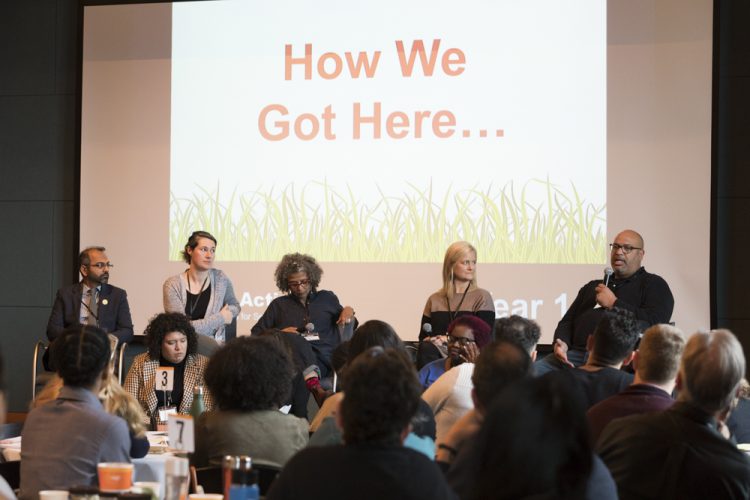MASS Action seeks to align museums with more equitable and inclusive practices. As the museum field begins to shape its identity in the 21st century, MASS Action, in collaboration with stakeholders across the field, is creating a platform for public dialogues on a variety of topics and issues affecting communities locally and globally, leading to actionable practices for greater equity and inclusion in our institutions. Through a series of public convenings and the creation of a toolkit of resources, the intention is to share the strategies and frameworks needed to address these important topics.
Last month, The Phillips Collection’s Chief Diversity Officer Makeba Clay, Senior Curator Elsa Smithgall, and Head of Public Programming Kelley Daley, attended the MASS Action conference at the Minneapolis Institute of Art. In this two part series, we discuss their key takeaways and what’s next.
In part two, we talk with Elsa Smithgall about what the conference meant to her.
What is the role and responsibility of the museum in responding to issues affecting communities locally and globally? From the beginning, The Phillips Collection founder Duncan Phillips sought to share his art collection with the Washington, DC, community by opening the doors of his Dupont Circle home to the public. Several years later, in his statement “A Collection in the Making,” Phillips expressed his aim for the museum to serve as a “beneficent force in the community”—a welcoming, intimate space for visitors to engage with art to stimulate the mind and refresh the soul.
The Phillips Collection shares with all museums a responsibility to be accessible to all communities—local, national, and international. If museums are to remain relevant, institutions must be responsive to the social issues of our time and make concerted efforts to reach broader, more diverse audiences that represent the current demographics of our pluralistic society.
Why does this work matter and where do you hope it will lead? Advancing this work to create more inclusive and socially-engaged institutions is critical to the future vitality and sustainability of the field. While there are no easy, quick fixes to dismantling deeply ingrained cultures of colonialism and white privilege in our institutions, I am hopeful that with increased education, activism, and determination, progress will come.
What do you think museums must change internally so that they are better equipped to make the external changes necessary to foster an inclusive environment? Museums must first instill and model an inclusive organizational culture across the entire institution before they can expect to develop a genuinely inclusive public-facing side. At the Phillips, the museum affirmed its commitment to these efforts with the addition earlier this year of our first chief diversity officer, Makeba Clay, on the senior leadership team. Working across the institution, Makeba is advancing diversity, equity, inclusion, and accessibility in all aspects of our operations and practice, from the establishment of our first paid internship program to help foster a more diverse pipeline of emerging practitioners in the field, to instituting new hiring practices to eradicate implicit bias, and organizing ongoing training and learning opportunities to raise awareness, build empathy, and equip managers and staff with the tools and knowledge they need to create more inclusive work environments.
What was your biggest “a-ha” moment at the convening? One big “a-ha” moment for me came during a break-out session on storytelling and liberating the narrative. During this discussion, a participant spoke about the narrative she was developing for an object label on two porcelain tea cups. Rather than contextualize them in terms of their craftsmanship or their function in upper class society, she planned to speak about the cups from the perspective of the servants whose job it was to clean them. The idea of seeing objects from another lens inspired me to think about the kinds of untold, marginalized stories that we might discover when we challenge the dominant narrative, and how The Phillips Collection will tell its story at the time of our centennial in 2021.
How can the museum be used as a site for social action? During the dark hour of World War II, Phillips avowed the necessity of art as a counter force to oppression: “The rallying point of opposition to all those destructive anti-social forces.” Phillips understood the integral role museums can play in raising awareness and stimulating action around social justice issues affecting the lives of its communities. Whether through its exhibitions, collections, educational activities, programs, partnerships, website, or outreach, museums can provide opportunities for deep reflection and insight—powerful creative catalysts for social action.

